Analysis of Maritime Trade Growth: Challenges and Opportunities in Sight
The latest “Shipping Review & Outlook” report from Clarksons makes it clear that global maritime trade growth will experience a significant slowdown, projecting an increase of only 0.5% in 2025. This is in contrast to the 2.4% achieved in 2024, indicating a scenario of increasing uncertainty. Trade tensions, geopolitical conflicts, and the challenges of decarbonisation are factors that play a decisive role in this slowdown. The report highlights that only 4% of global trade has been affected by new tariffs this year. However, changes such as the 3% decrease in Chinese imports and the increase in OPEC exports have had a significant impact. Additionally, the 70% decrease in Red Sea transits has revitalized other naval routes, increasing transport demand by 2.5%. The sector faces a complex combination of elements that, while presenting challenges, also offer opportunities for professionals and investors in the maritime industry. In this sense, being aware of these changes and adapting to them is crucial to remain competitive in an increasingly volatile market.
Opportunities in the Container Carriers and Tankers Sectors
- The container carrier sector shows divergent behavior, with time charter rates hitting record highs, tripling the values from the end of 2023. However, container rates remain volatile, below 2024 levels, creating a significant opportunity for informed investors and operators to navigate these fluctuations with well-informed strategies.
- On the other hand, the tanker sector is booming, with VLCCs exceeding $90,000 per day. This situation is due to limited fleet growth, increased production from OPEC+, and the impact of international sanctions. These factors solidify the tanker sector as an interesting area for new businesses and investments.
These sectors offer maritime professionals a way to capitalize on emerging opportunities. Those interested in advancing their careers in these areas should consider submitting their resumes to companies expanding their presence in these markets.
Challenges in the Bulk Carriers and Gas Carriers Sectors
- The bulk carrier market remains at moderate levels, with average earnings of $13,000 per day, although Capesize vessels have reached $25,000 due to increased bauxite exports from Guinea. However, the challenge for professionals and operators is how to manage the volatility that characterizes this segment.
- In the gas carrier sector, while LPG carriers have shown stability due to trade tensions between the US and China, the future of LNG carriers is more uncertain due to the increase in the operational fleet and future changes in production capacity. This scenario requires careful planning and more efficient risk management.
For maritime investors, understanding the internal dynamics of these markets is vital to mitigate risks and maximize potential rewards. Additionally, this translates into the need for well-prepared and trained teams to face these challenging scenarios.
Innovations and Sustainability in Shipbuilding
- The expected fleet growth for 2025 and 2026 is projected at 4%, with the gas carrier and container carrier sectors leading this increase. China maintains its dominance in shipbuilding, accounting for 55% of orders, while scrapping remains low despite the aging fleet.
- Prices for new vessels, although down 2% this year, are still 50% above 2020 levels. One of the most crucial areas in the maritime sector is energy transition. Currently, 9% of the global fleet is enabled to operate with alternative fuels, and this percentage is expected to double by 2030. However, international consensus on the measures to be taken remains stalled.
The upcoming IMO vote in October could set a new course in this necessary transformation. Technological advancements and investment in port infrastructures for alternative fuels are aspects that sector professionals must closely monitor. Furthermore, the focus on sustainability is increasingly becoming a decisive factor in the industry as environmental regulations pressure companies to innovate and adapt to meet new standards.
Conclusions: Strategies for the Future
- As maritime trade faces a combination of challenges and opportunities, strategic preparation is essential. For merchant navy professionals and maritime investors, understanding these changes and anticipating market trends will be key to maintaining their position in the sector.
- The importance of adaptation is fundamental. With the weakening of trade growth, the evolution of energy transition, and the impact of geopolitics, companies must be prepared to redirect their efforts towards emerging areas and optimize their operations in the face of market volatility.
- Finally, for nautical enthusiasts wishing to explore new opportunities, this market fluctuation is an invitation to delve deeper into sector knowledge and consider options that may not have been visible before.
It is clear that the future of maritime trade is full of challenges but also unexplored possibilities, and navigating in this environment requires both courage and strategic vision.






